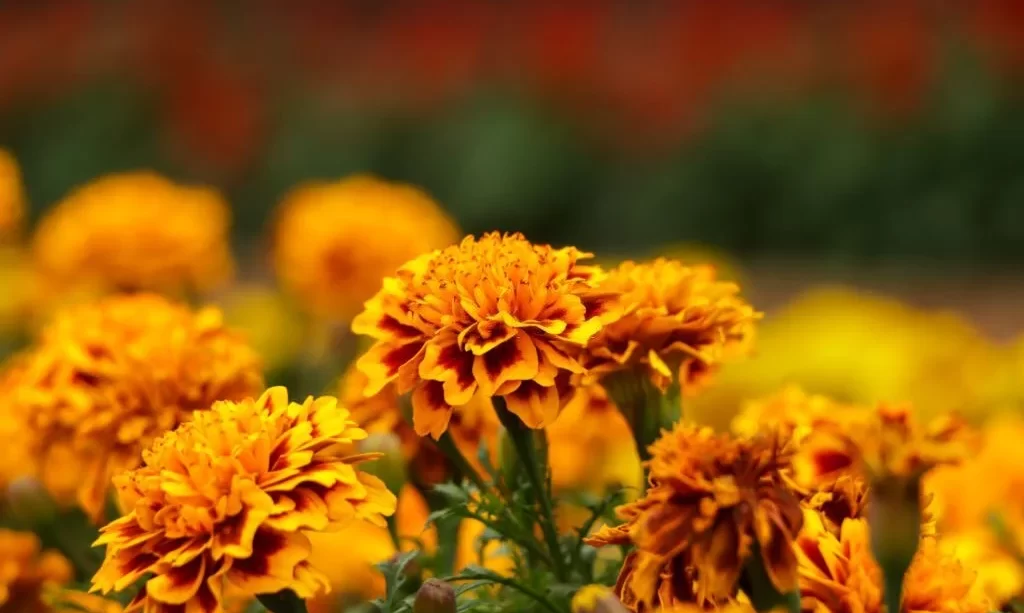Marigolds, with their radiant and cheerful blooms, have long been a favorite among gardeners and flower enthusiasts. Their vibrant colors and distinct fragrance make them a popular choice for adding a touch of beauty to gardens, landscapes, and even pots on windowsills. These versatile flowers are known not only for their aesthetic appeal but also for their potential to repel certain pests from the garden. In this article, we will explore the fascinating world of marigolds, from their botanical characteristics to their role in gardens and the various factors that influence their growth and care.
- 1000 Seeds – French Marigold Sparky Mix – Beautiful Flowers and Good Protection in Vegetable Gardens
- Easy to Grow. Wonderful addition to flower gardens.
- Annual flower popular in all zones.
Marigolds
Marigolds belong to the genus Tagetes and are part of the Asteraceae family, which is commonly referred to as the daisy or aster family. These flowering plants are native to regions of North and South America, but they have gained global popularity for their adaptability and captivating blossoms.
Marigolds are characterized by several distinctive features:
- Colorful Blooms: Marigolds come in a range of colors, including vibrant shades of yellow, orange, and red. Some varieties even feature bi-colored or multi-petaled blossoms, adding to their visual appeal.
- Scented Flowers: Many marigold varieties emit a unique and often pleasant fragrance, which can vary from mildly citrusy to somewhat spicy. This fragrance can have practical applications, such as pest deterrence.
- Different Species: There are various species and cultivars of marigolds, each with its own growth habits, sizes, and flower types. Common marigold species include African marigolds (Tagetes erecta), French marigolds (Tagetes patula), and signet marigolds (Tagetes tenuifolia), among others.
- Edible and Medicinal Uses: Beyond their ornamental value, marigolds have been used in traditional medicine and cooking. The petals of some marigold varieties are edible and can be used to add color and flavor to salads, soups, and teas.
Marigold Sun Requirements
Marigolds are renowned for their affinity for sunlight. They thrive when basking in the warmth of the sun’s rays. Adequate sunlight is essential for several aspects of marigold growth and development:
- Flower Production: Marigolds are prolific bloomers, and they require abundant sunlight to produce an abundance of colorful blossoms. Sunlight is the energy source that fuels the process of photosynthesis, enabling the plant to convert carbon dioxide and water into sugars, which are used for growth and flowering.
- Plant Structure: Sunlight influences the overall structure of marigold plants. In full sun, marigolds tend to develop sturdy stems and compact growth habits. This results in a well-formed and attractive appearance.
- Healthy Foliage: Marigolds exposed to adequate sunlight typically boast lush, green foliage. The leaves play a crucial role in photosynthesis, capturing sunlight and facilitating the production of energy for the plant.
Can Marigolds Grow in Shade?
While marigolds undeniably thrive in full sun, gardeners often wonder if they can successfully cultivate these flowers in shaded areas. Here are some key insights into marigolds’ potential to grow in the shade:
- Limited Flowering: Marigolds planted in shaded or partially shaded areas may exhibit reduced flowering compared to those in full sun. Insufficient sunlight can lead to fewer blossoms and diminished overall vibrancy.
- Varietal Differences: It’s worth noting that some marigold varieties exhibit more tolerance for shade than others. French marigolds (Tagetes patula) are generally more adaptable to partial shade compared to African marigolds (Tagetes erecta), which have a stronger preference for full sun.
- Dappled Shade vs. Deep Shade: Marigolds have a higher likelihood of thriving in dappled or light shade where they still receive indirect sunlight during parts of the day. Deep shade, characterized by minimal to no direct sunlight, is less conducive to robust marigold growth.
When considering growing marigolds in shaded areas, gardeners should assess the specific conditions of their garden or landscape. Factors such as geographical location, soil quality, and the degree of shade can all impact the success of marigold cultivation. Providing adequate watering and ensuring well-drained soil are essential steps in supporting marigolds’ growth, even in partially shaded environments.
Factors Influencing Success in Shade
Several factors come into play when determining whether marigolds can successfully grow in shaded conditions:
- Light Intensity: The degree of shade can vary significantly, from light dappled shade to deep, dense shade. Light shade may still provide enough sunlight for marigolds to thrive to some extent, while deep shade is less accommodating.
- Variety Selection: The choice of marigold variety matters. Some, like French marigolds, are better suited to partial shade, while others, such as African marigolds, prefer full sun. Selecting shade-tolerant marigold varieties increases the likelihood of success in less sunny areas.
- Duration of Shade: Consider how long the shaded conditions persist during the day. Marigolds can tolerate short periods of shade but may struggle in areas with prolonged shade.
- Soil Quality: Well-draining soil with good fertility is essential for marigolds, regardless of sunlight levels. Amending the soil with compost and organic matter can enhance the plant’s ability to cope with less-than-ideal light conditions.
- NUTRIENT RICH & INDOOR/OUTDOOR FAST GERMINATION… Wonder Soil Premium Organic Potting Soil Mix is the only dry compressed coco coir mix with added amendments of worm castings, mycorrhizae, kelp, perlite and more! Grow your plants faster with stronger roots! Peat free, all natural, family and pet safe!
- A LITTLE DOES A LOT… your little BIG bag of compressed indoor potting soil & garden soil for outdoor plants expands to 4 TIMES THE SIZE when mixed with water; easy to carry & saves vital shed space.
- PRE-MIXED & READY TO USE ORGANIC POTTING MIX … Pre-mixed and ready to use organic potting soil and garden soil mix to help make your gardening or hobby growing a breeze. Simply transplant your desired plants into their new container and add our soil mix or pour our soil mix and plant your seeds.
- WATER RETENTION & DRAINAGE… Coco coir has excellent water retention with dependable drainage and aeration in the root zone. Save up to 50% of water, fertilizer, and seed!
- HEAVY DUTY RESEALABLE BAG… Use what you need and save the rest for later! Keeping your planting soil dry and safe!
Ideal Conditions for Marigolds
To maximize the growth and vibrancy of marigolds, providing them with their preferred conditions is advisable:
- Full Sun: Marigolds thrive in full sun, which typically means at least 6-8 hours of direct sunlight per day. Planting them in sunny locations encourages lush foliage and abundant flowering.
- Well-Drained Soil: Marigolds prefer well-draining soil to prevent waterlogged roots, which can lead to rot. Amending the soil with organic matter like compost can improve drainage.
- Spacing: Proper spacing between marigold plants allows for good air circulation, reducing the risk of fungal diseases. Follow the recommended spacing guidelines for your specific marigold variety.
- Watering: Marigolds appreciate regular, even watering. Avoid overhead watering, as wet foliage can be susceptible to diseases. Instead, aim to water at the base of the plant.
Conclusion
Marigolds are renowned for their preference for full sun, where they showcase their dazzling blooms and lush foliage to their fullest potential. While some marigold varieties, such as French marigolds, can tolerate partial shade, the overall health and flowering of these plants are optimized in well-lit locations.
When considering growing marigolds in shaded areas, gardeners should assess the specific conditions of their garden and choose shade-tolerant marigold varieties. While marigolds may survive in partial shade, providing them with their preferred conditions, including ample sunlight and well-draining soil, will result in the most robust and vibrant plants. Whether adorning garden beds, borders, or containers, marigolds are sure to bring a burst of color and charm to any outdoor space when provided with the right environment.





